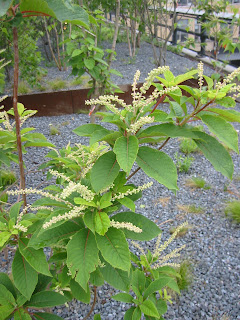

If ever there were a respectable, modest and seemly tree it is the Common Hornbeam, Carpinus betulus. It is composed, soigne, adaptable to city conditions and untroubled by disease, pests or outbursts of floral display. Like most things that are valued for their irreproachable decency, the hornbeam usually goes unnoticed, but Dirr judges it "one of the very finest landscape trees." Then, curiously, he says it possesses an "...air of aloofness unmatched by any plant." I'm not sure that I would describe its polish as "aloof," but once you start noticing, you fall into characterizations.
The Common Hornbeam is European. We have a nice native species that is less often seen in the city: Carpinus caroliniana. It's smooth sinewy grey bark is notable.
I was pleased to see saplings of a few other species at the Brooklyn Botanic Garden. Carpinus orientalis (right) is from southeast Europe and Asia Minor and might tolerate city heat better than C. betulus. The elegant long leaf of C. japonicus (center) attracted me, but Dirr, citing examples from Georgia commented that the leaves were bedraggled by late summer and "the literature has been kinder to the species that its performance warrants." C. coreana (left) has a splendid little leaf.
Of these less common forms, only C. coreana is widely available. Nurseries specializing in bonsai carry it.


